Related Research Articles
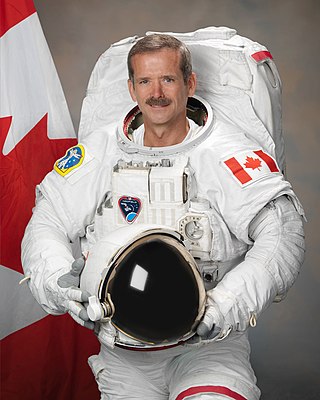
Chris Austin Hadfield is a Canadian retired astronaut, engineer, fighter pilot, musician, and writer. The first Canadian to perform extravehicular activity in outer space, he has flown two Space Shuttle missions and also served as commander of the International Space Station (ISS). Prior to his career as an astronaut, he served in the Canadian Armed Forces for 25 years as an Air Command fighter pilot.

Spacelab was a reusable laboratory developed by European Space Agency (ESA) and used on certain spaceflights flown by the Space Shuttle. The laboratory comprised multiple components, including a pressurized module, an unpressurized carrier, and other related hardware housed in the Shuttle's cargo bay. The components were arranged in various configurations to meet the needs of each spaceflight.

The Canadian Space Agency is the national space agency of Canada, established in 1990 by the Canadian Space Agency Act.

Robert Brent "Bob" Thirsk, is a Canadian retired engineer and physician, and a former Canadian Space Agency astronaut. He holds the Canadian record for the most time spent in space. He became an officer of the Order of Canada (OC) in 2013 and was named to the Order of British Columbia (OBC) in 2012.
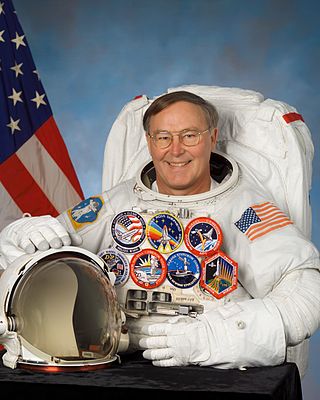
Jerry Lynn Ross is a retired United States Air Force officer, engineer, and a former NASA astronaut. Ross is a veteran of 7 Space Shuttle missions, making him the joint record holder for most spaceflights.

Richard Michael Mullane is an engineer and weapon systems officer, a retired USAF officer, and a former NASA astronaut. During his career, he flew as a mission specialist on STS-41-D, STS-27, and STS-36.
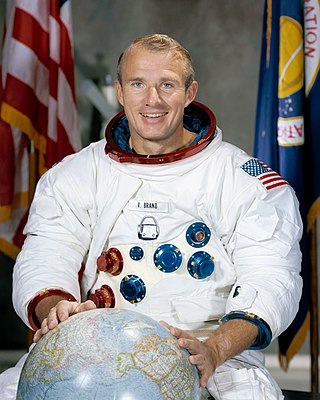
Vance DeVoe Brand is an American naval officer, aviator, aeronautical engineer, test pilot, and NASA astronaut. He served as command module pilot during the first U.S.-Soviet joint spaceflight in 1975, and as commander of three Space Shuttle missions.

STS-85 was a Space Shuttle Discovery mission to perform multiple space science packages. It was launched from Kennedy Space Center, Florida, on 7 August 1997. A major experiment was the CRISTA-SPAS free-flyer which had various telescopes on board.
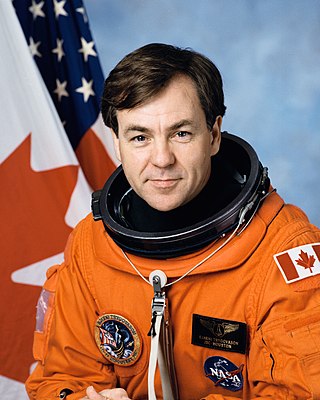
Bjarni Valdimar Tryggvason was an Icelandic-born Canadian engineer and a NRC/CSA astronaut. He served as a Payload Specialist on Space Shuttle mission STS-85 in 1997, a 12-day mission to study changes in the Earth's atmosphere.

Dafydd Rhys "David" Williams is a Canadian physician, public speaker, author and retired CSA astronaut. Williams was a mission specialist on two Space Shuttle missions. His first spaceflight, STS-90 in 1998, was a 16-day mission aboard Space Shuttle Columbia dedicated to neuroscience research. His second flight, STS-118 in August 2007, was flown by Space Shuttle Endeavour to the International Space Station. During that mission he performed three spacewalks, becoming the third Canadian to perform a spacewalk and setting a Canadian record for total number of spacewalks. These spacewalks combined for a total duration of 17 hours and 47 minutes.

STS-74 was the fourth mission of the US/Russian Shuttle–Mir program, and the second docking of the Space Shuttle with Mir. Space Shuttle Atlantis lifted off from Kennedy Space Center launch pad 39A on 12 November 1995. The mission ended 8 days later with the landing of Atlantis back at Kennedy. It was the second in a series of seven straight missions to the station flown by Atlantis.

STS-100 was a Space Shuttle mission to the International Space Station (ISS) flown by Space Shuttle Endeavour. STS-100 launch on 19 April 2001, and installed the ISS Canadarm2 robotic arm.

Robert Joseph "Bob" Cenker is an American aerospace and electrical engineer, aerospace systems consultant, and former astronaut. Cenker worked for 18 years at RCA Astro-Electronics, and its successor company GE Astro Space, on a variety of spacecraft projects. He spent most of his career working on commercial communications satellites, including the Satcom, Spacenet and GStar programs.
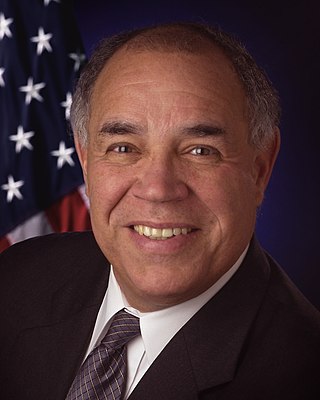
Frederick Drew Gregory is a former United States Air Force pilot, military engineer, test pilot, and NASA astronaut as well as former NASA Deputy Administrator. He also served briefly as NASA Acting Administrator in early 2005, covering the period between the departure of Sean O'Keefe and the swearing in of Michael D. Griffin.

Kathryn Patricia "Kay" Hire is a former NASA astronaut and Captain in the U.S. Navy Reserve who has flown aboard two Space Shuttle missions.

Joan Elizabeth Higginbotham is an electrical engineer and a former NASA astronaut. She flew aboard Space Shuttle Discovery mission STS-116 as a mission specialist and is the third African American woman to go into space, after Mae Jemison and Stephanie Wilson.

A payload specialist (PS) was an individual selected and trained by commercial or research organizations for flights of a specific payload on a NASA Space Shuttle mission. People assigned as payload specialists included individuals selected by the research community, a company or consortium flying a commercial payload aboard the spacecraft, and non-NASA astronauts designated by international partners.
The Manned Spaceflight Engineer Program was an effort by the United States Air Force to train American military personnel as payload specialists for United States Department of Defense missions on the Space Shuttle program.
The Canadian Astronaut Corps is a unit of the Canadian Space Agency (CSA) that selects, trains, and provides astronauts as crew members for U.S. and Russian space missions. The corps has four active members, able to serve on the International Space Station (ISS).
References
- 1 2 Burgess, Colin (May 2019). Shattered Dreams: The Lost and Canceled Space Missions. U of Nebraska Press. ISBN 9781496206756.
- ↑ "Apollo 11 anniversary inspires next generation of astronauts | Globalnews.ca". globalnews.ca. 2019-07-20. Retrieved 2019-08-11.
- ↑ Doyle, Richard I. (2001). Renaissance II: Canadian Creativity and Innovation in the New Millennium. NRC Research Press. ISBN 9780660183978.
- ↑ Lowey, Mark (July 4, 1992). "Calgary astronaut bows out". Calgary Herald . p. B4. ProQuest 2263051201.
- ↑ Marsh, James H. (1999). The Canadian Encyclopedia. The Canadian Encyclopedia. ISBN 9780771020995.
- ↑ Simpson, Kieran (1994). The Canadian Who's who. University of Toronto Press. ISBN 9780802046772.
- ↑ Marsh, James H. (1999). The Canadian Encyclopedia. The Canadian Encyclopedia. ISBN 9780771020995.
- ↑ "Biography of Michael McKay". www.asc-csa.gc.ca. 2015-01-28. Retrieved 2019-08-13.
- ↑ "Canada reveals two new astronauts during 150th anniversary celebration | collectSPACE". collectSPACE.com. Retrieved 2019-08-13.